fold seats INFINITI Q50 2019 Owners Manual
[x] Cancel search | Manufacturer: INFINITI, Model Year: 2019, Model line: Q50, Model: INFINITI Q50 2019Pages: 468, PDF Size: 2.15 MB
Page 25 of 468
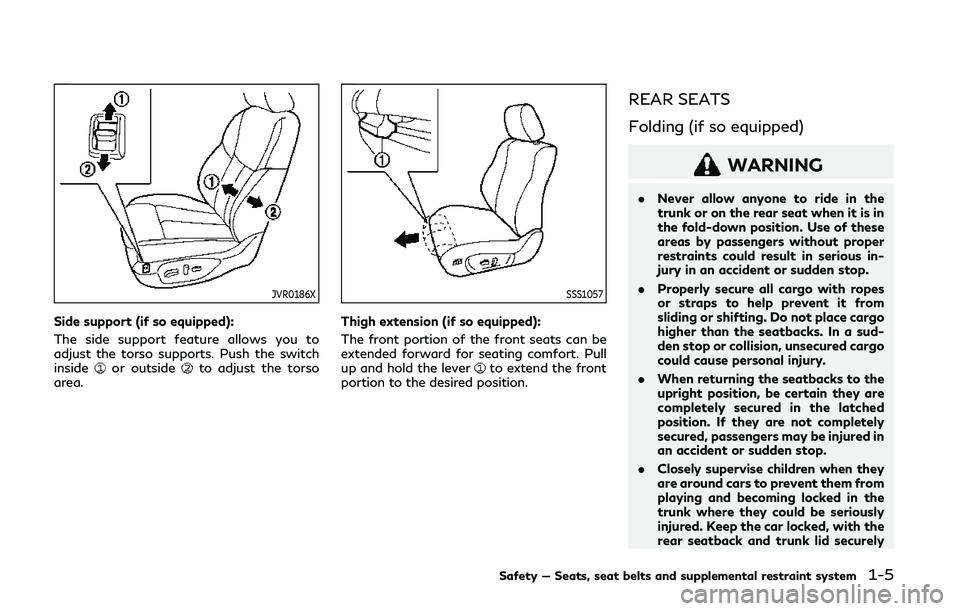
JVR0186X
Side support (if so equipped):
The side support feature allows you to
adjust the torso supports. Push the switch
inside
or outsideto adjust the torso
area.
SSS1057
Thigh extension (if so equipped):
The front portion of the front seats can be
extended forward for seating comfort. Pull
up and hold the lever
to extend the front
portion to the desired position.
REAR SEATS
Folding (if so equipped)
WARNING
. Never allow anyone to ride in the
trunk or on the rear seat when it is in
the fold-down position. Use of these
areas by passengers without proper
restraints could result in serious in-
jury in an accident or sudden stop.
. Properly secure all cargo with ropes
or straps to help prevent it from
sliding or shifting. Do not place cargo
higher than the seatbacks. In a sud-
den stop or collision, unsecured cargo
could cause personal injury.
. When returning the seatbacks to the
upright position, be certain they are
completely secured in the latched
position. If they are not completely
secured, passengers may be injured in
an accident or sudden stop.
. Closely supervise children when they
are around cars to prevent them from
playing and becoming locked in the
trunk where they could be seriously
injured. Keep the car locked, with the
rear seatback and trunk lid securely
Safety — Seats, seat belts and supplemental restraint system1-5
Page 26 of 468
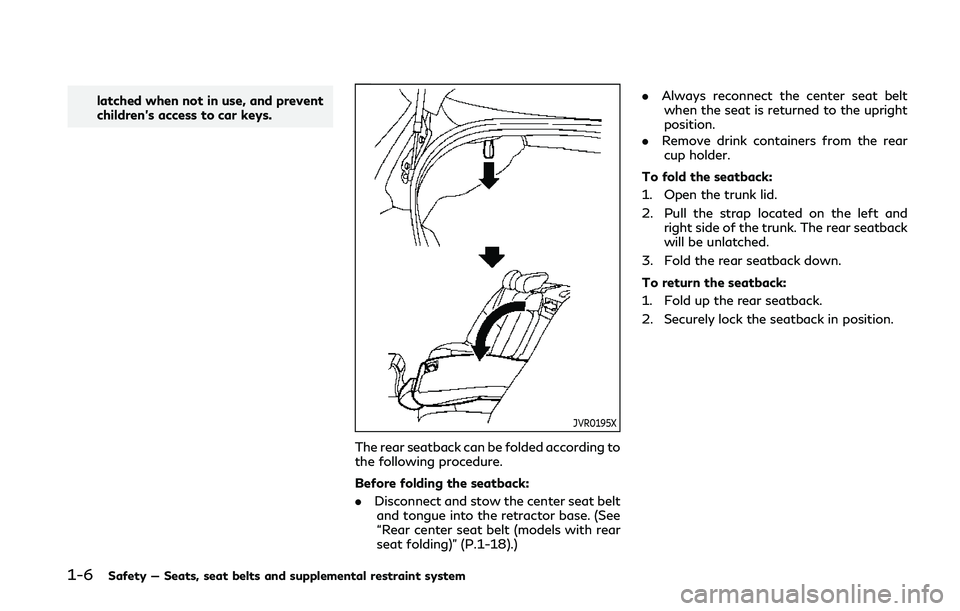
1-6Safety — Seats, seat belts and supplemental restraint system
latched when not in use, and prevent
children’s access to car keys.
JVR0195X
The rear seatback can be folded according to
the following procedure.
Before folding the seatback:
.Disconnect and stow the center seat belt
and tongue into the retractor base. (See
“Rear center seat belt (models with rear
seat folding)” (P.1-18).) .
Always reconnect the center seat belt
when the seat is returned to the upright
position.
. Remove drink containers from the rear
cup holder.
To fold the seatback:
1. Open the trunk lid.
2. Pull the strap located on the left and right side of the trunk. The rear seatback
will be unlatched.
3. Fold the rear seatback down.
To return the seatback:
1. Fold up the rear seatback.
2. Securely lock the seatback in position.
Page 27 of 468
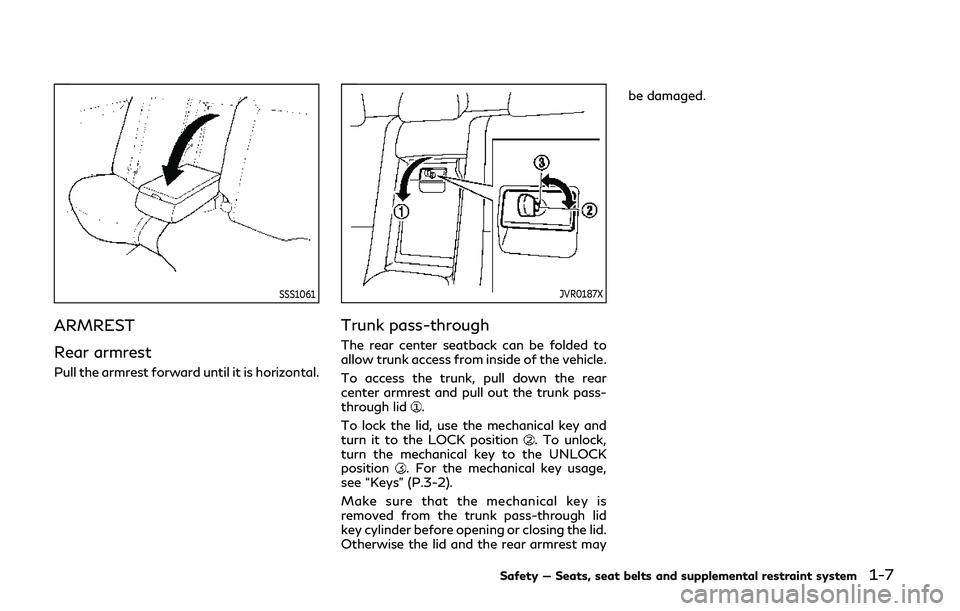
SSS1061
ARMREST
Rear armrest
Pull the armrest forward until it is horizontal.
JVR0187X
Trunk pass-through
The rear center seatback can be folded to
allow trunk access from inside of the vehicle.
To access the trunk, pull down the rear
center armrest and pull out the trunk pass-
through lid
.
To lock the lid, use the mechanical key and
turn it to the LOCK position
. To unlock,
turn the mechanical key to the UNLOCK
position
. For the mechanical key usage,
see “Keys” (P.3-2).
Make sure that the mechanical key is
removed from the trunk pass-through lid
key cylinder before opening or closing the lid.
Otherwise the lid and the rear armrest may be damaged.
Safety — Seats, seat belts and supplemental restraint system1-7
Page 35 of 468

THREE-POINT TYPE SEAT BELT
WARNING
.Every person who drives or rides in
this vehicle should use a seat belt at
all times.
. Do not ride in a moving vehicle when
the seatback is reclined. This can be
dangerous. The shoulder belt will not
be against your body. In an accident,
you could be thrown into it and
receive neck or other serious injuries.
You could also slide under the lap belt
and receive serious internal injuries.
. For the most effective protection
when the vehicle is in motion, the
seat should be upright. Always sit
well back and upright in the seat with
both feet on the floor and adjust the
seat belt properly.
JVR0256X
Models with rear seat folding
WARNING
Do not allow children to play with the
seat belts. Most seating positions are
equipped with Automatic Locking Re-
tractor (ALR) mode seat belts. If the seat
belt becomes wrapped around a child’s
neck with the ALR mode activated, the
child can be seriously injured or killed if
the seat belt retracts and becomes tight.
This can occur even if the vehicle is
parked. Unbuckle the seat belt to release
the child. For the center of the rear seat
on the models with rear seat folding, the connector tongue
may also be re-
leased. Release the connector tongue by
inserting a suitable tool (such as a key)
into the connector buckle
. If the seat
belt can not be unbuckled or is already
unbuckled, release the child by cutting
the seat belt with a suitable tool (such as
a knife or scissors) to release the seat
belt.
Safety — Seats, seat belts and supplemental restraint system1-15
Page 38 of 468
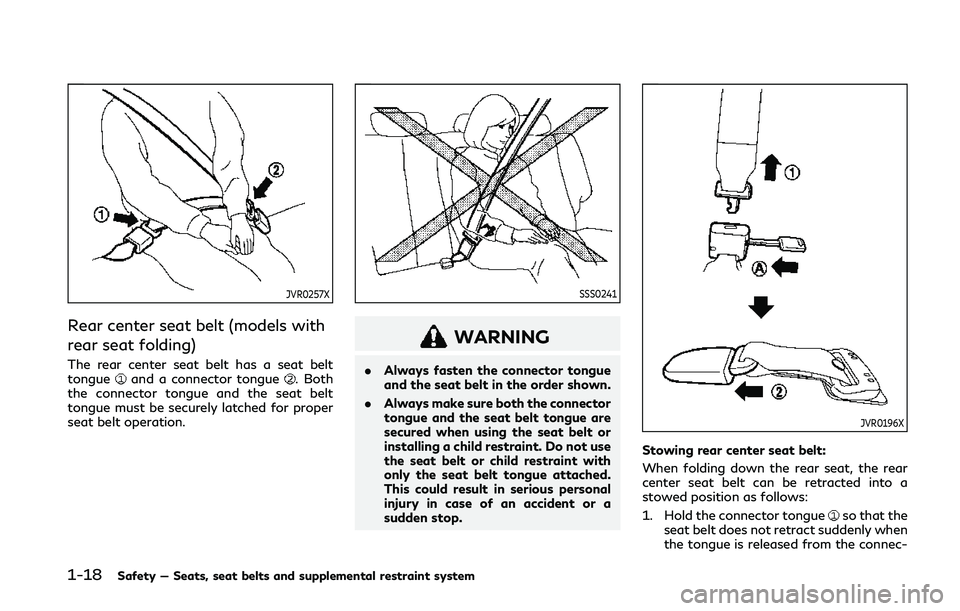
1-18Safety — Seats, seat belts and supplemental restraint system
JVR0257X
Rear center seat belt (models with
rear seat folding)
The rear center seat belt has a seat belt
tongueand a connector tongue. Both
the connector tongue and the seat belt
tongue must be securely latched for proper
seat belt operation.
SSS0241
WARNING
. Always fasten the connector tongue
and the seat belt in the order shown.
. Always make sure both the connector
tongue and the seat belt tongue are
secured when using the seat belt or
installing a child restraint. Do not use
the seat belt or child restraint with
only the seat belt tongue attached.
This could result in serious personal
injury in case of an accident or a
sudden stop.
JVR0196X
Stowing rear center seat belt:
When folding down the rear seat, the rear
center seat belt can be retracted into a
stowed position as follows:
1. Hold the connector tongue
so that the
seat belt does not retract suddenly when
the tongue is released from the connec-
Page 39 of 468
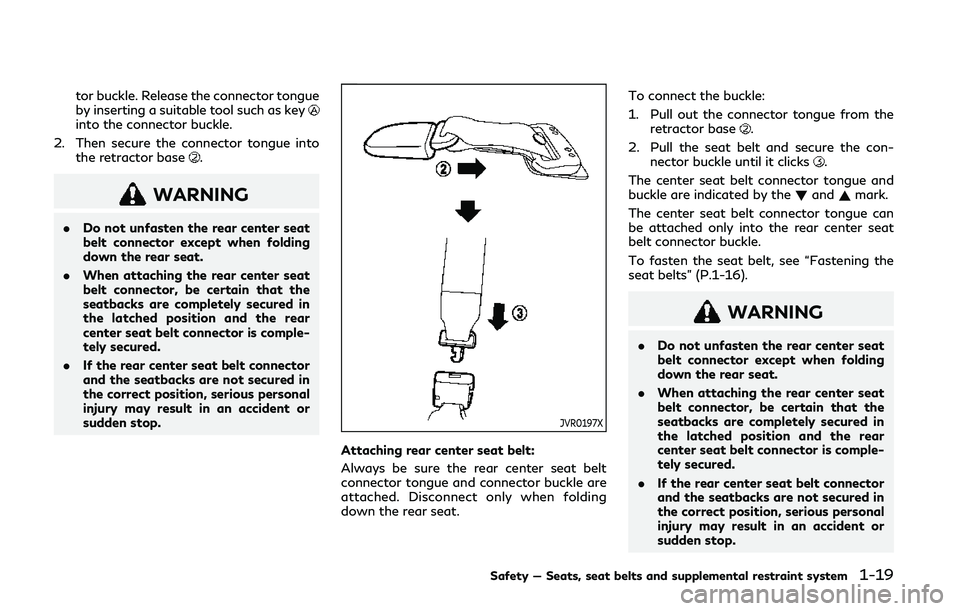
tor buckle. Release the connector tongue
by inserting a suitable tool such as key
into the connector buckle.
2. Then secure the connector tongue into the retractor base
.
WARNING
.Do not unfasten the rear center seat
belt connector except when folding
down the rear seat.
. When attaching the rear center seat
belt connector, be certain that the
seatbacks are completely secured in
the latched position and the rear
center seat belt connector is comple-
tely secured.
. If the rear center seat belt connector
and the seatbacks are not secured in
the correct position, serious personal
injury may result in an accident or
sudden stop.
JVR0197X
Attaching rear center seat belt:
Always be sure the rear center seat belt
connector tongue and connector buckle are
attached. Disconnect only when folding
down the rear seat. To connect the buckle:
1. Pull out the connector tongue from the
retractor base
.
2. Pull the seat belt and secure the con- nector buckle until it clicks
.
The center seat belt connector tongue and
buckle are indicated by the !and ~mark.
The center seat belt connector tongue can
be attached only into the rear center seat
belt connector buckle.
To fasten the seat belt, see “Fastening the
seat belts” (P.1-16).
WARNING
. Do not unfasten the rear center seat
belt connector except when folding
down the rear seat.
. When attaching the rear center seat
belt connector, be certain that the
seatbacks are completely secured in
the latched position and the rear
center seat belt connector is comple-
tely secured.
. If the rear center seat belt connector
and the seatbacks are not secured in
the correct position, serious personal
injury may result in an accident or
sudden stop.
Safety — Seats, seat belts and supplemental restraint system1-19
Page 41 of 468
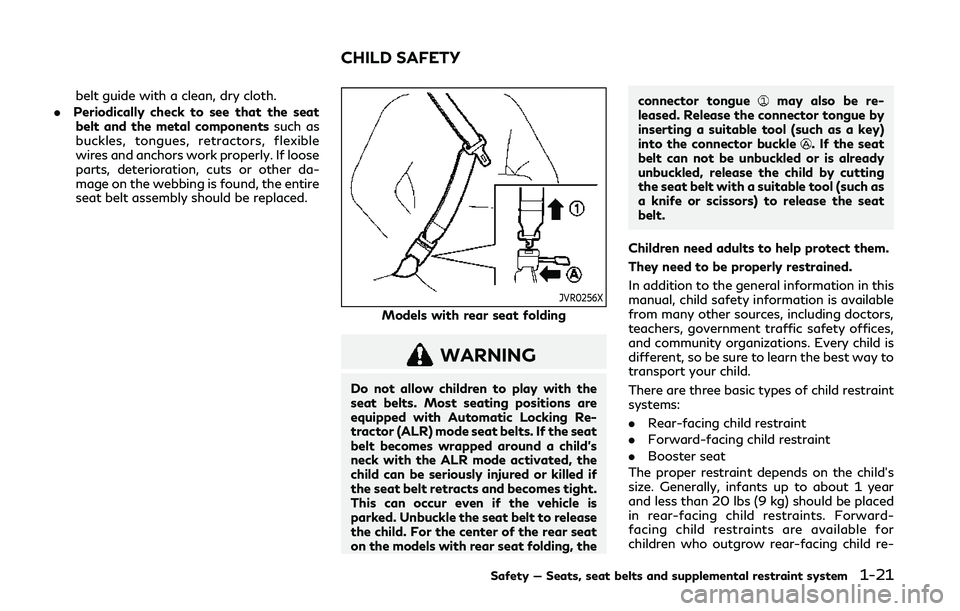
belt guide with a clean, dry cloth.
. Periodically check to see that the seat
belt and the metal components such as
buckles, tongues, retractors, flexible
wires and anchors work properly. If loose
parts, deterioration, cuts or other da-
mage on the webbing is found, the entire
seat belt assembly should be replaced.
JVR0256X
Models with rear seat folding
WARNING
Do not allow children to play with the
seat belts. Most seating positions are
equipped with Automatic Locking Re-
tractor (ALR) mode seat belts. If the seat
belt becomes wrapped around a child’s
neck with the ALR mode activated, the
child can be seriously injured or killed if
the seat belt retracts and becomes tight.
This can occur even if the vehicle is
parked. Unbuckle the seat belt to release
the child. For the center of the rear seat
on the models with rear seat folding, the connector tongue
may also be re-
leased. Release the connector tongue by
inserting a suitable tool (such as a key)
into the connector buckle
. If the seat
belt can not be unbuckled or is already
unbuckled, release the child by cutting
the seat belt with a suitable tool (such as
a knife or scissors) to release the seat
belt.
Children need adults to help protect them.
They need to be properly restrained.
In addition to the general information in this
manual, child safety information is available
from many other sources, including doctors,
teachers, government traffic safety offices,
and community organizations. Every child is
different, so be sure to learn the best way to
transport your child.
There are three basic types of child restraint
systems:
. Rear-facing child restraint
. Forward-facing child restraint
. Booster seat
The proper restraint depends on the child’s
size. Generally, infants up to about 1 year
and less than 20 lbs (9 kg) should be placed
in rear-facing child restraints. Forward-
facing child restraints are available for
children who outgrow rear-facing child re-
Safety — Seats, seat belts and supplemental restraint system1-21
CHILD SAFETY
Page 45 of 468

keep the following points in mind:
.Choose only a restraint with a label
certifying that it complies with Federal
Motor Vehicle Safety Standard 213 or
Canadian Motor Vehicle Safety Stan-
dard 213.
. Check the child restraint in your vehicle to
be sure it is compatible with the vehicle’s
seat and seat belt system.
. If the child restraint is compatible with
your vehicle, place your child in the child
restraint and check the various adjust-
ments to be sure the child restraint is
compatible with your child. Choose a
child restraint that is designed for your
child’s height and weight. Always follow
all recommended procedures.
. If the combined weight of the child and
child restraint is less than 65 lbs (29.5
kg), you may use either the LATCH
anchors or the seat belt to install the
child restraint (not both at the same
time).
. If the combined weight of the child and
child restraint is greater than 65 lbs (29.5
kg), use the vehicle’s seat belt (not the
lower anchors) to install the child re-
straint.
. Be sure to follow the child restraint
manufacturer’s instructions for installa-
tion. All U.S. states and Canadian provinces or
territories require that infants and small
children be restrained in an approved child
restraint at all times while the vehicle is
being operated. Canadian law requires the
top tether strap on forward-facing child
restraints be secured to the designated
anchor point on the vehicle.
JVR0188X
Models with rear seat folding
SSS0567
Models without rear seat folding
Safety — Seats, seat belts and supplemental restraint system1-25
Page 46 of 468

1-26Safety — Seats, seat belts and supplemental restraint system
Lower Anchors and Tethers for
CHildren System (LATCH)
Your vehicle is equipped with special anchor
points that are used with the LATCH (Lower
Anchors and Tethers for CHildren) system
compatible child restraints. This system may
also be referred to as the ISOFIX or ISOFIX
compatible system. With this system, you do
not have to use a vehicle seat belt to secure
the child restraint unless the combined
weight of the child and child restraint
exceeds 65 lbs (29.5 kg). If the combined
weight of the child and child restraint is
greater than 65 lbs (29.5 kg), use the
vehicle’s seat belt (not the lower anchors)
to install the child restraint. Be sure to follow
the child restraint manufacturer’s instruc-
tions for installation.
LATCH lower anchor
WARNING
Failure to follow the warnings and
instructions for proper use and installa-
tion of child restraints could result in
serious injury or death of a child or other
passengers in a sudden stop or collision:
.Attach LATCH system compatible
child restraints only at the locations shown in the illustration.
. Do not secure a child restraint in the
center rear seating position using the
LATCH lower anchors. The child re-
straint will not be secured properly.
. Inspect the lower anchors by insert-
ing your fingers into the lower anchor
area. Feel to make sure there are no
obstructions over the anchors such as
seat belt webbing or seat cushion
material. The child restraint will not
be secured properly if the lower
anchors are obstructed.
Child restraint anchorages are designed
to withstand only those loads imposed
by correctly fitted child restraints. Under
no circumstances are they to be used to
attach adult seat belts, or other items or
equipment to the vehicle. Doing so could
damage the child restraint anchorages.
The child restraint will not be properly
installed using the damaged anchorage,
and a child could be seriously injured or
killed in a collision.
SSS0840
Models with rear seat folding
SSS0637
Models without rear seat folding
Page 50 of 468
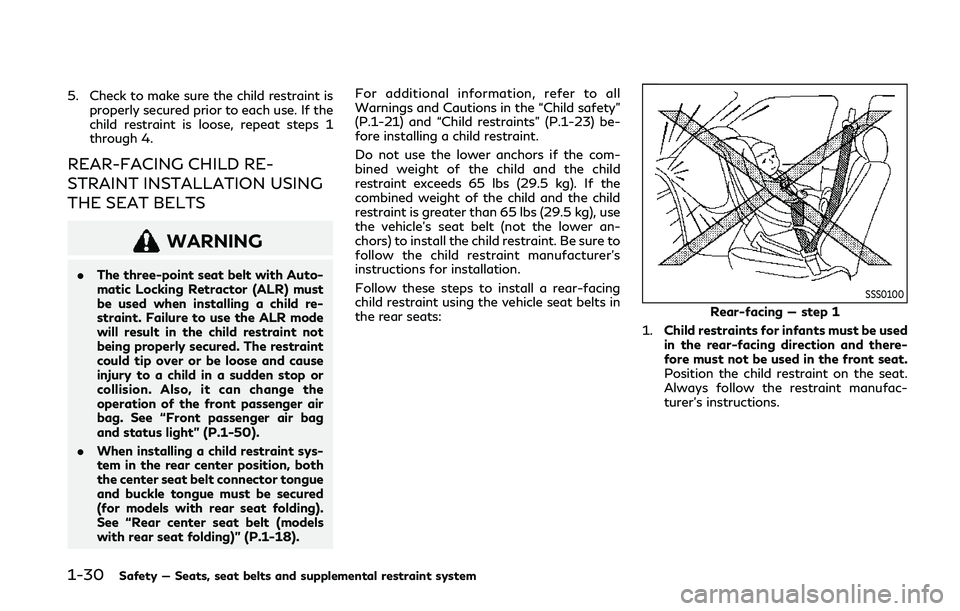
1-30Safety — Seats, seat belts and supplemental restraint system
5. Check to make sure the child restraint isproperly secured prior to each use. If the
child restraint is loose, repeat steps 1
through 4.
REAR-FACING CHILD RE-
STRAINT INSTALLATION USING
THE SEAT BELTS
WARNING
.The three-point seat belt with Auto-
matic Locking Retractor (ALR) must
be used when installing a child re-
straint. Failure to use the ALR mode
will result in the child restraint not
being properly secured. The restraint
could tip over or be loose and cause
injury to a child in a sudden stop or
collision. Also, it can change the
operation of the front passenger air
bag. See “Front passenger air bag
and status light” (P.1-50).
. When installing a child restraint sys-
tem in the rear center position, both
the center seat belt connector tongue
and buckle tongue must be secured
(for models with rear seat folding).
See “Rear center seat belt (models
with rear seat folding)” (P.1-18). For additional information, refer to all
Warnings and Cautions in the “Child safety”
(P.1-21) and “Child restraints” (P.1-23) be-
fore installing a child restraint.
Do not use the lower anchors if the com-
bined weight of the child and the child
restraint exceeds 65 lbs (29.5 kg). If the
combined weight of the child and the child
restraint is greater than 65 lbs (29.5 kg), use
the vehicle’s seat belt (not the lower an-
chors) to install the child restraint. Be sure to
follow the child restraint manufacturer’s
instructions for installation.
Follow these steps to install a rear-facing
child restraint using the vehicle seat belts in
the rear seats:
SSS0100
Rear-facing — step 1
1. Child restraints for infants must be used
in the rear-facing direction and there-
fore must not be used in the front seat.
Position the child restraint on the seat.
Always follow the restraint manufac-
turer’s instructions.